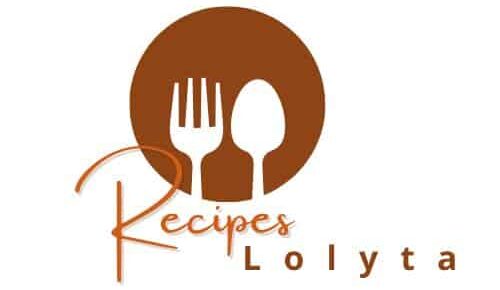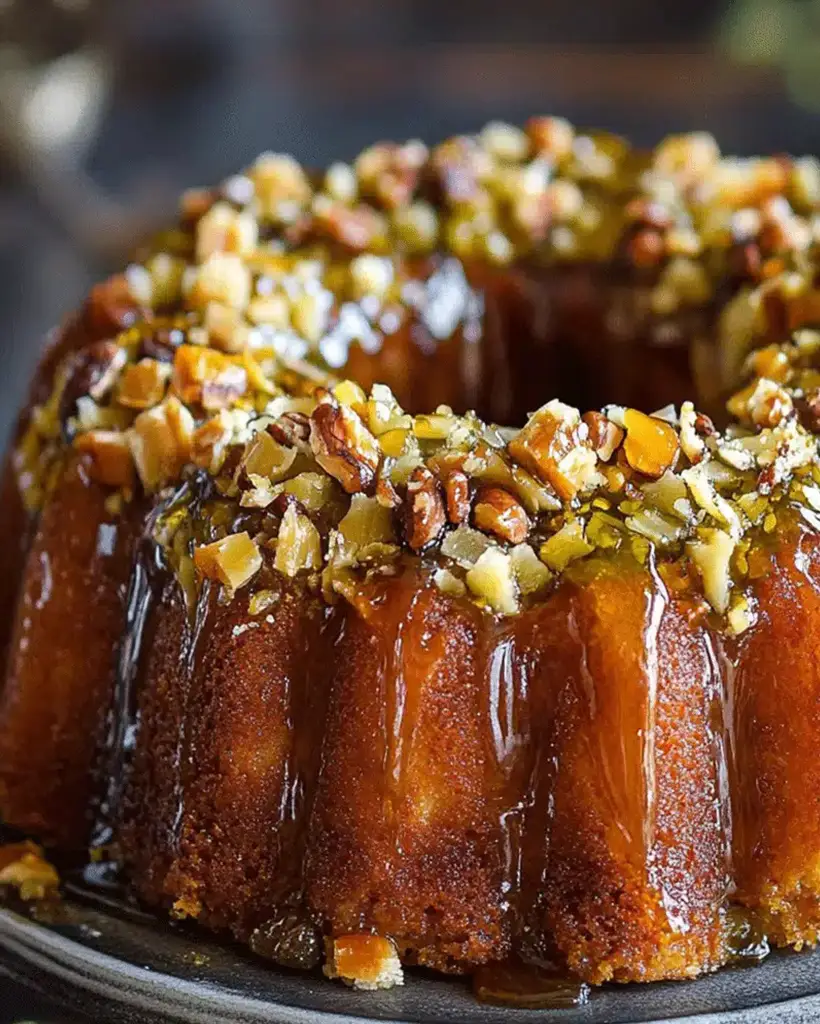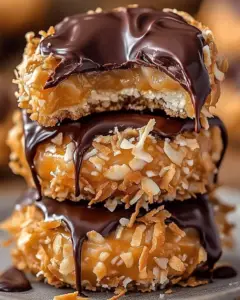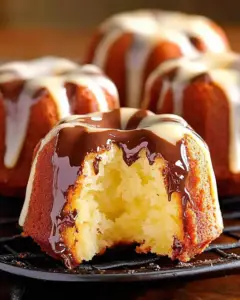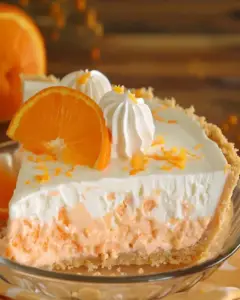Baklava Bundt Cake Recipe: A Delectable Dessert Delight
Imagine the luscious, nutty flavors of traditional baklava infused into the form of a bundt cake, and you have our Baklava Bundt Cake. This dessert combines the rich and buttery pastry layers of baklava with the moist, fluffy texture of a bundt cake. With a perfect balance of sweetness and spice, this Baklava Bundt Cake is ideal for dessert lovers who crave something unique yet authentically familiar. Its golden crust and aromatic spices make it a showstopper at any gathering, promising to please and surprise your guests with every bite.
This Baklava Bundt Cake recipe brings together the essence of Mediterranean cuisine and the timeless appeal of a classic bundt cake. With each slice, you’ll uncover layers of spiced nuts, drizzled with a sweet honey syrup that captures the traditional baklava flavor. Whether you’re looking to impress for a dinner party or simply enjoy a luxurious afternoon treat, this dessert fits the bill. It’s the kind of treat that evokes memories of holiday feasts and brings warmth and comfort with every forkful.
Quick Recipe Highlights
- Flavor Profile: The Baklava Bundt Cake exudes a harmonious blend of cinnamon, nutmeg, and walnuts, drizzled with honey that provides a sweet, aromatic depth.
- Texture: Experience the amalgamation of crunchy nut layers intertwined with a perfectly moist and soft cake, creating a delightful contrast.
- Aroma: A rich, inviting aroma of spices and honey fills the air, reminiscent of freshly baked baklava straight from the oven.
- Visual Appeal: Golden-brown and beautifully glazed, the cake’s intricate bundt shape adds an elegant touch, making it a feast for the eyes.
- Skill Level Needed: An intermediate level of baking skill is required to achieve the perfect layering and syrup texture.
- Special Equipment: A bundt pan and pastry brush are essential tools for crafting this visually stunning and flavorful cake.
Recipe Overview
- Difficulty Level: The intermediate difficulty stems from the cake’s layering and syrup-making processes, which require precision and finesse.
- Category: This dessert is a unique twist on the traditional baklava, offering a cake variation suitable for tea time or special occasions.
- Cuisine: Rooted in Mediterranean culinary traditions, it embodies the classic flavors of baklava while celebrating the baking artistry of bundt cakes.
- Cost: The recipe calls for accessible pantry staples like flour, sugar, and nuts, making it an affordable yet indulgent dessert option.
- Season: Best enjoyed during the cooler months when warm spices are especially comforting, but delightful all year round.
- Occasion: Perfect for holiday tables, festive gatherings, or as an impressive centerpiece for a family celebration.
Why You’ll Love This Recipe
The Baklava Bundt Cake seamlessly marries taste and texture, offering a cake that is both moist and studded with crunchy nuts. Its sweet and slightly spiced profile makes it a deliciously indulgent treat that perfectly captures the essence of traditional baklava. Convenience is also a major factor. Unlike making a traditional baklava, which involves careful pastry layering, this recipe has simplified the process, making it a fuss-free delight that still offers the full festive experience in a fraction of the time.
Nutritionally, the Baklava Bundt Cake is enriched with walnuts that provide omega-3 oils and a good source of proteins. These nuts contribute to a heart-healthy dessert choice, delivering nutritional benefits without sacrificing flavor or indulgence. On a social level, this cake invites conversation; its intricate design and delightful flavor are often the highlight of any dessert spread, providing an entertaining piece for guests to admire and savor.
This dessert is also notably cost-effective, with its ingredients being widely available and budget-friendly. Although it embraces the luxurious taste of baklava, it doesn’t require specialty items or excessive preparation time, making it an accessible option for home bakers. Overall, the Baklava Bundt Cake promises to fill your kitchen with warmth, delighting those who savor its rich, spiced flavors. Its elegance and flavor harmony easily turn any simple gathering into a memorable feast.
Historical Background and Cultural Significance
The art of baklava originated within the Mediterranean empires, where pastry chefs of unique skill devised complex, sweet pastries celebrating their culture’s love for nuts and honey. The Baklava Bundt Cake draws from this rich history, iterating on a beloved classic dessert that showcases the ingenuity rooted in Mediterranean culinary arts. As this cake evolves from baklava, it maintains its cultural heritage while innovatively adapting to modern baking trends.
Baklava traditionally held a special place during festive celebrations, where its lavish use of nuts and spices was considered luxurious. The Baklava Bundt Cake captures this festive spirit, designed to bring a celebratory essence to modern gatherings. It retains the cultural significance of bringing warmth and togetherness, which baklava is renowned for, while making it more accessible to bakers domestically.
The evolution of baklava into a cake form reflects culinary daring. Chefs today seek to redefine traditional recipes by infusing contemporary techniques and stylish presentation. By transforming it into a bundt cake, we preserve its essential characteristics while catering to diversified palates who wish to experience baklava’s savory and sweet joy in a different form. Regional variations in the Mediterranean continue to influence new recipes, inspiring endless adaptations and creative culinary pursuits.
Ingredient Deep Dive
Walnuts are the star of this Baklava Bundt Cake, historically treasured in Mediterranean cuisines for their rich, earthy flavors and health benefits. They are an excellent source of manganese and copper, essential for bone health and metabolic function, and their robust nutty essence matches perfectly with the sweet spices in this cake. When selecting walnuts, look for fresh, crisp nuts without any discoloration or off odor, and store them in an airtight container in a cool place to preserve their freshness.
Honey is another pivotal ingredient, holding deep cultural importance as a natural sweetener revered throughout history for its healing properties and rich flavor. It offers antibacterial benefits and contributes to the moistness and complexity of flavor in this dessert. Choose raw, organic honey for its purity and depth of flavor, and store it in a tightly sealed container at room temperature to maintain its quality. Substitute options include maple syrup for a different subtle sweetness while maintaining the cake’s tenderness.
Common Mistakes to Avoid
- Misjudging the Cake Batter Consistency: Ensure your cake batter is neither too thin nor too thick, impacting the final texture.
- Ignoring the Importance of Layering: Proper nut mixture layering is crucial to replicate the baklava essence.
- Not Using a Bundt Pan Correctly: Grease every crevice to prevent sticking; this is vital for easy removal.
- Overcooking the Cake: Monitor baking time closely; overcooked cake can become dry.
- Underestimating the Impact of Fresh Ingredients: Fresh nuts and honey drastically influence the cake’s flavor profile.
- Skipping the Syrup Soak: Allow your cake to soak up the syrup adequately for authentic baklava flavor.
- Incorrect Cake Release Technique: Let the cake cool before attempting removal; premature action may cause breakage.
- Forgetting to Toast the Nuts: Toasted nuts enhance flavor but must be watched to avoid burning.
Essential Techniques
Layering the nut mixture throughout the cake batter is an essential technique that mirrors the authentic layers found in traditional baklava. Achieving an even spread of nuts with each layer of batter creates a harmonious distribution of flavors and textures upon baking. Attention to detail during this step ensures that each bite maintains the characteristic complexity of baklava while ensuring the cake maintains its structural integrity.
Creating the honey syrup is another critical technique, requiring precise heating to avoid crystallization. Mastering this syrup enables the cake to absorb the intended sweet flavors without becoming overly sticky. Visual cues to monitor include a shiny, pourable syrup consistency that thickens slightly upon cooling but remains pliable enough to drizzle over the bundt cake.
Pro Tips for Perfect Baklava Bundt Cake
Increase the aroma and depth by incorporating a splash of rose or orange blossom water into the syrup—these infusions echo the floral notes typical in Mediterranean desserts. When assembling the cake, allow the nut mixture layers to cool before adding subsequent batter. This prevents unwanted densification in the finished cake layers. Utilizing a cake leveler can ensure evenly distributed batter, essential for uniform baking.
Greasing the bundt pan thoroughly using brush-applied softened butter guarantees against sticking, capturing the intricate details of the bundt shape. For an elevated presentation, garnish the cooled cake with a light dusting of edible gold leaf, appealing visually but also conveying the luxury synonymous with baklava. Take your time when drizzling the syrup; proper cake soaking optimizes flavor infusion without compromising the cake’s integrity. For added richness, whole milk yogurt in the batter can improve cake tenderness and add subtle tartness.
Variations and Adaptations
Regional adaptations might include the incorporation of pistachios instead of walnuts, adding a vibrant green color and distinctive flavor profile that’s especially prominent in Middle Eastern baklava. For a seasonal take, incorporating dried cranberries provides a tanginess that complements the sweet syrup, offering a wintery twist. Dietary modifications cater to gluten-sensitive individuals by employing gluten-free flour alternatives while still achieving a similar delicious texture.
Flavor variations such as lavender or chamomile in the syrup can produce quaint floral notes perfect for summer gatherings. To modify texture, incorporating finely shredded phyllo pastry into the batter bond each layer even further, providing additional complexity that emulates authentic baklava. For contemporary serving, consider smaller, individualized bundt molds to present as personal-sized desserts, allowing friends and family to enjoy personal servings with ease.
Serving and Presentation Guide
Employ careful plating using an elegant cake stand to prominently feature your Baklava Bundt Cake, highlighting its intricate design. Garnish the top with raw walnuts or edible flowers to create a visual focal point. Consider traditional accompaniments such as Greek coffee to enhance the dessert experience. Alternatively, a dollop of whipped cream with subtle spices along the side delivers a comforting pairing.
Modernly, serving this cake slightly warmed allows the aroma to tempt guests before tasting. Temperature considerations include room temperature for controlled syrup absorption without drying, ensuring moist enjoyment with each slice. Portion control suggests slicing along the bundt’s natural ridges to maintain aesthetic integrity while managing serving sizes, aligning with various desserts or alongside a robust after-dinner espresso.
Wine and Beverage Pairing
Pairing options start with an aromatic Muscat wine, typical for Mediterranean desserts, offering complementary notes of raisin and honey, harmonizing with the cake flavors. For non-alcoholic alternatives, consider iced herbal tea, such as hibiscus, which balances the cake’s richness with a refreshing contrast. Should coffee or tea appeal, a strong chai or Turkish coffee enhances the nutty and spiced elements of the dessert.
Temperature considerations are essential; wine should be slightly chilled, maintaining its refreshing contrast to the cake. Serve beverages in chilled or warmed glasses, enhancing the overall sensory experience that pairs beautifully with each cake slice. Encourage serving suggestions that highlight personal taste preferences while promoting exploration of new flavor combinations that elevate culinary enjoyment.
Storage and Shelf Life
Store the Baklava Bundt Cake in an airtight container or wrapped tightly with plastic wrap at room temperature to maintain freshness up to three days. If desired, refrigerate for extended storage of up to a week, ensuring the cake retains moisture. Ideal containers can include resealable cake domes, preventing drying by maintaining an optimal environment. Watch for spoilage signs such as off odors or texture changes.
When reheating, slice portions and warm gently in a microwave or low oven to refresh the cake’s softness without drying it out. For longer preservation, wrap individual slices in plastic wrap and place them in a freezer-safe bag for freezing up to three months. Defrost at room temperature to ensure the best experience when ready to indulge again.
Make Ahead Strategies
Plan the Baklava Bundt Cake’s preparation by organizing ingredients into stages; make the nut mixture and the syrup in advance to allow flavor melding. Store the syrup in a sealable container at room temperature, ready for immediate use. Quality impacts remain minimal over a few days of storage if kept airtight and cool.
Assembly tips include layering with precision; ensure nut mixture consistency between layers, rotating gently for even distribution. Reheating guidelines include slight warming to coax the cake back to aromatic warmth before showcasing. For fresh element additions, consider preparing a light citrus glaze to drizzle just before serving, enhancing visual appeal and taste.
Scaling Instructions
Successfully halving the Baklava Bundt Cake recipe requires precise division of ingredients and smaller bakeware, reducing cook time appropriately while maintaining cinnamon nut flavors. When scaling up, secure larger pan options, monitor for extended cooking time, and prepare multiple syrup batches to maintain even flavor coverage. Review equipment such as mixer capacity, confirming ability to accommodate increased quantities.
Timing modifications might include staggered baking by employing multiple oven racks for uniform results. Storage considerations should include additional air-tight containers for batch making. A meticulous approach ensures completion without compromise on quality or presentation, preserving flavor integrity and guest satisfaction.
Nutritional Deep Dive
A macro breakdown reveals that the Baklava Bundt Cake is a high-carb treat due to its flour and sugar base, combined with moderate fats from butter and nuts. Micronutrient highlights showcase its commendable mineral content from walnuts, such as vitamin E and magnesium. Emphasizing portion-controlled slices ensures a balanced indulgence that does not offset health objectives.
The cake’s unwavering inclusion of heart-friendly properties, thanks to its nut composition, offers notable health benefits, especially when enjoyed moderately. Dietary considerations entail awareness of its sugar content, but occasional enjoyment facilitates a guilt-free delighting experience. Portion analysis encourages consciousness, savoring each bite for maximum enjoyment without unintended overconsumption.
Dietary Adaptations
For gluten-free modifications, opting for all-purpose gluten-free flour blends ensures suitable substitutes without flavor loss or texture inadequacy. Dairy-free options include using plant-based butter substitutes and coconut milk, providing similar moist characteristics. Vegan adaptations call for flax “egg” mixtures combined with plant-based syrups like agave.
Low-carb alternatives incorporate almond flour instead of traditional wheat-based options, reducing carb content while complementing the nutty profile. For keto-adaptations, augment with artificial sweeteners yet retain aromatic spices. Paleo enthusiasts benefit from alternative flours like almond, maintaining holistic integrity while respecting dietary choices. Low-FODMAP versions result from careful adjustment of sweeteners, minimizing discomfort while enjoying classic flavors.
Troubleshooting Guide
Texture issues can arise from incorrect batter consistency; ensuring ingredients are integrated correctly often corrects this. For flavor balance, adjust spice ratios or syrup sweetness to personal preference, maintaining harmonious flavors. Temperature problems involve accurate oven calibration to prevent uneven cooking.
Overlooking equipment challenges, such as pan sizing mismatches, is avoided by confirming accurate measurements align with recipe scaling adjustments before baking. Ingredient substitutions need careful review; alternative dairy can affect consistency but can be adjusted. Timing concerns address erratic baking by adhering to recommended guidelines, adjusting for altitude or oven variations.
Recipe Success Stories
Community feedback frequently highlights the Baklava Bundt Cake as a standout dessert providing nostalgic flavors with a creative twist. Variations like pistachio incorporation or citrus-infused glazes have met with success, demonstrating creativity without boundaries. Reader suggestions on presentation enhancements include layer imagery or specialty platter showcases for lavish sharing occasions.
Photography tips suggest strategic lighting; natural backgrounds enhance a cake’s golden hues, pulling focus and admiration. Showcase individual slices or syrup-poured cross sections, illustrating layers and highlighting texture. Shared success stories advance inspiration for home bakers, motivating further recipe exploration while reinforcing achievement satisfaction upon perfect creation.
Frequently Asked Questions
Absolutely! Experiment with almonds or pistachios to alter the flavor profile. Ensure nuts are fresh to enhance taste.
2. What is the best way to grease a bundt pan?
Brushing softened butter into crevices ensures even greasing. Flour application afterward creates a non-stick surface ensuring smooth release.
3. Can I make the syrup ahead of time?
Yes, syrup benefits from flavor development over time. Store in a tight container at room temperature until ready to use.
4. How do I prevent the cake from becoming dry?
Monitor bake time diligently and allow sufficient cake cooling pre-release to maintain moisture retention within layers.
5. Any tips for toasting the nuts?
Toast in a single layer, avoiding overcrowding, until fragrance emerges, typically over moderate heat without browning.
6. How can I best serve this cake for an event?
Sliced at the table with pre-poured syrup creates an ambient serving show, enhancing communal gathering enjoyment.
7. Can this cake be frozen?
Yes, wrap individual slices and freeze up to three months, with defrosting in ambient conditions before serving.
8. How do I adjust for high altitude baking?
Decrease sugar slightly and increase flour slightly, while raising oven temperature 15-20 degrees for optimal results.
9. What can I substitute for honey if I’m allergic?
Opt for maple syrup or agave nectar, retaining syrup consistency and sweetness while catering to allergic requirements.
10. How can I make the cake more festive?
Incorporate fruit zest or edible gold flakes as decoration, enhancing visual charm while presenting as the holiday centerpiece.
11. Is this recipe suitable for a spring-themed celebration?
Certainly, using fresh or dried floral decorations completes spring presentations, enhancing the cake’s natural beauty.
12. What’s the ideal syrup consistency?
Aim for a thick yet pourable syrup that will evenly coat and soak into the cake without creating excess moisture.
Additional Resources
Exploring related recipes such as Pistachio Baklava or Walnut Tea Cakes can expand your dessert repertoire, offering variety while maintaining familiar flavors. Technique guides on baking precision with tools like cake thermometers or leveling scrapers support skill development and success. Dive into the intricate specifics about ingredient origins and usage, such as how varying honey types affect taste outcomes.
Investigate equipment recommendations to optimize baking efficiency or enhancements like bundt pans with unique patterns. Exploring seasonal variation suggestions inspires creativity, especially when marrying flavors that resonate with individual or cultural preferences. Embrace these resources to elevate baking mastery and enrich culinary experiences within this delightful domain.
Print
Baklava Bundt Cake
Description
A delightful cake combining the flavors of traditional baklava with the classic form of a bundt cake.
Ingredients
For the Crust:
- 2 cups all-purpose flour
- 1 cup granulated sugar
- 1 cup unsalted butter, softened
- 1/2 cup honey
- 3 large eggs
- 1 teaspoon vanilla extract
- 1 teaspoon baking powder
- 1/2 teaspoon baking soda
- 1/2 teaspoon salt
- 1 cup chopped walnuts
- 1 teaspoon ground cinnamon
Instructions
1. Prepare the Crust:
- Preheat the oven to 350°F (175°C) and grease a bundt pan.
- In a large bowl, cream the butter and sugar until light and fluffy. Add the eggs one at a time, beating well after each addition. Mix in the honey and vanilla extract.
- In another bowl, whisk together the flour, baking powder, baking soda, and salt. Gradually add the dry ingredients to the wet ingredients, mixing until just combined. Fold in the chopped walnuts and cinnamon.
- Pour the batter into the prepared bundt pan and bake for 30-35 minutes, or until a toothpick inserted into the center comes out clean. Allow to cool in the pan for about 10 minutes, then invert onto a wire rack to cool completely.
Notes
You can customize the seasonings to taste.
